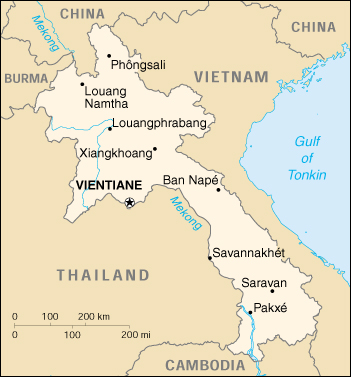

Status Quo Side: Laotian neutralists
Non-Status Quo Side: Right and Left factions
Region: Pacific, East Asia & SE Asia
Conflict Type: Primarily Internal
Issues in Dispute: Governance Strategic
Neutralist Premier Souvanna Phouma had succeeded by November 1957 in working with both the rightist faction and the communist Pathet Lao (PL) for a neutral Laos (sought by the 1954 Geneva Accords). The latter was undermined when, after a special election in May 1958 in which PL sympathizers won 9 of 21 contests, the rightists took power. The International Control Commission (ICC) meanwhile suspended operations.
North Vietnamese forces, long behind Laotian and Cambodian guerrillas, penetrated 12 miles into Laos ostensibly to force ICC reactivation. The rightist government, over neutralist and PL parliamentary objections, renounced the Geneva Accords, making possible the acceptance of US military aid.
Disagreement over incorporating 2 PL battalions into the Laotian army (as agreed in 1957) triggered protracted fighting. Charges of North Vietnamese intervention and of Soviet complicity evoked Soviet and Chinese complaints of US Geneva violations. Both sides were armed from abroad. In April/May 1960, in elections widely considered fraudulent, rightists won the entire Assembly. On August 9 1960 neutralist rebels under Long Le restored Souvanna Phouma, but rightist attacks, allegedly aided by the US and Thailand, reinstated rightists under Boum Oum in December. In January 1961 the US alerted Pacific bases to an alleged "Communist invasion". On taking office President John F. Kennedy was warned by outgoing President Dwight D. Eisenhower that Laos would be a major crisis for him. Kennedy decided to seek a neutral solution. This was made possible by a joint UK-USSR call for a cease-fire, a reactivated ICC and a new Geneva conference. Despite a May agreement on a cease-fire, fighting continued during prolonged Geneva negotiations and while talks took place between Boun Oum (under US pressure to negotiate), Souvanna Phouma and PL leader Souphonouvong. On May 3 1962 a PL attack (which some charged was provoked) near the Chinese border led to a major US troop buildup in Thailand and renewed crisis. A 3-way coalition was installed on June 22.
The new Cabinet proclaimed a cease-fire. Most US troops in Thailand were withdrawn. The Geneva Conference agreed on July 23 to Laotian neutrality and withdrawal of foreign forces.
In March 1963 sporadic fighting resumed. Clearly the PL had North Vietnamese aid in occupying much of the northeast. A year later the PL had severed all ties with the neutralist government of Souvanna Phouma and in 1965 was officially renamed the Lao People's Liberation Army. Peace talks in 1972 and a cease-fire in 1973 preceded formation of a coalition government between neutralists and the PL. After the fall of Cambodia and South Vietnam to communist insurgents, PL forces moved on the Laotian capital Vientiane. On December 2 1975 the monarchy was abolished, the coalition government terminated, and a People's Democratic Republic established. After the USSR collapsed Laos sought Western aid and in 1992 signed a treaty of friendship with Thailand. In 1997 Laos was admitted to ASEAN membership.